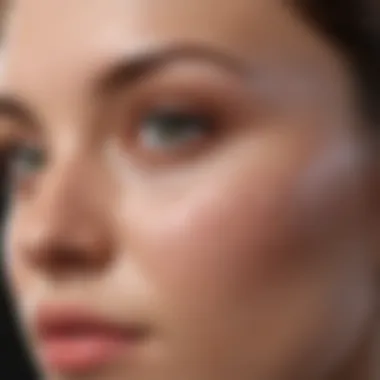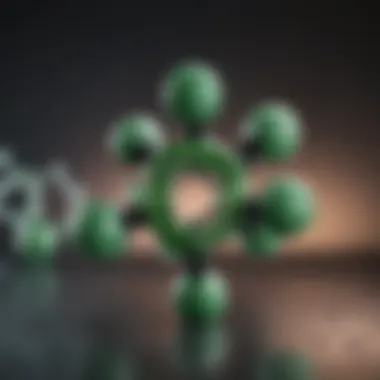Understanding Hydroquinone Cream: Uses and Implications


Intro
Hydroquinone cream is a topical agent widely recognized for its skin-lightening properties. This compound is primarily used for treating conditions associated with hyperpigmentation, such as melasma, dark spots, and age spots. Despite its efficacy, hydroquinone has generated considerable debate regarding its safety and regulatory status. The complexities surrounding its use necessitate a careful examination of its benefits, potential side effects, and the ethical implications of its widespread application.
In this article, we will dissect the various aspects of hydroquinone cream. From understanding its mechanisms of action to exploring its role in different skin types, we aim to give a comprehensive view of its applications. Moreover, our discussion will include a look into the regulatory landscape that governs its use and alternatives available for those impacted by skin discoloration. By shedding light on these elements, we hope to elevate the conversation around hydroquinone and its implications for public health.
Key Findings
Major Results
Hydroquinone cream has shown remarkable efficacy in skin lightening and is most effective in treating various forms of hyperpigmentation. Studies indicate that the concentration of hydroquinone used can significantly influence its effectiveness. Typically, higher concentrations, such as 4%, have been linked with better results in alleviating skin discoloration. However, it is crucial to note that individual responses can vary based on skin type and the specific nature of the pigmentation.
"Hydroquinone is often considered the gold standard for skin-lightening; however, its use must be tailored to individual skin conditions and sensitivities."
Discussion of Findings
The primary action of hydroquinone involves the inhibition of melanin production by melanocytes, effectively reducing the appearance of darkened skin areas. It is often compounded with other agents, such as tretinoin or corticosteroids, to enhance its therapeutic effects and improve user compliance. Yet, while many users report satisfactory results, others experience adverse effects like skin irritation or permanent skin discoloration. Thus, a nuanced understanding of patient selection is essential for optimal outcomes when considering hydroquinone as a treatment option.
Methodology
Research Design
This article synthesizes findings from peer-reviewed studies, clinical guidelines, and regulatory documentation regarding hydroquinone cream. The goal is to present an evidence-based overview of its applications in dermatology.
Data Collection Methods
Data were collected through comprehensive literature reviews, including articles from dermatological journals and reports from health authorities. Emphasis was placed on studies that examined long-term effects, user compliance, and safety concerns associated with hydroquinone usage. Relevant information from sources such as Wikipedia and the Britannica also contributed to the insights presented here.
In summary, the use of hydroquinone cream presents both opportunities and challenges in the pursuit of skin health. By carefully weighing its benefits against potential risks, users and practitioners can make informed decisions regarding its application.
Intro to Hydroquinone Cream
Hydroquinone cream has emerged as a focal point in dermatological discussions, especially regarding its effectiveness in skin lightening and treatment of hyperpigmentation. Understanding this topical agent is necessitated by its broad application in various skin conditions, making it an essential element for both practitioners and patients. This section will explore the significance of hydroquinone, emphasizing its composition, use cases, and the factors surrounding its application.
Definition and Composition
Hydroquinone is a lightening agent that works through specific chemical mechanisms to reduce melanin production in the skin. Formulated as a topical cream, it commonly contains a concentration of 2% for over-the-counter variants and can reach up to 4% for prescription forms. The active component, hydroquinone, is a type of phenolic compound that inhibits enzymes responsible for melanin synthesis, particularly tyrosinase. This means that it directly targets the underlying cause of excessive pigmentation. Apart from hydroquinone, the creams may include stabilizers and emollients to enhance skin absorption and ensure stability of the product during storage.
Historical Context
The history of hydroquinone in dermatology reflects a timeline of evolving perspectives on its safety and efficacy. First synthesized in the late 19th century, hydroquinone was initially utilized in various industrial and photographic processes before its dermatological applications became prominent.
Over the decades, clinical studies began to validate its role in treating conditions like melasma and age spots. However, the usage of hydroquinone has been met with some controversy due to safety concerns, particularly in chronic use which has led to conditions like ochronosis - a bluish-black discoloration of the skin. Regulatory bodies in different countries have responded to these concerns in varied ways, which further complicates the narrative around hydroquinone's use. Understanding this historical context is critical for appreciating the current landscape of its application, benefits, and regulations.
Primary Uses of Hydroquinone Cream
The topic of hydroquinone cream is significant due to its diverse applications in dermatology. Hydroquinone is a powerful topical agent used primarily for skin lightening. Its formulations have been widely recognized, especially for treating various forms of hyperpigmentation. Understanding its primary uses aids healthcare providers, researchers, and patients alike in making more informed decisions regarding skin health.
Hyperpigmentation Treatment
Hyperpigmentation is a common concern across many demographics. It can be caused by sun exposure, hormonal changes, or skin injuries. Hydroquinone cream is primarily used to address this condition. The active ingredient works by inhibiting the production of melanin, the pigment responsible for skin color. Patients often find notable improvements in skin tone, resulting in a more uniform appearance. This effect is welcomed by those aiming for a clearer and brighter complexion.
Melasma Management
Melasma presents a unique challenge, as it usually affects women and can be triggered by hormonal shifts, particularly during pregnancy. Hydroquinone cream plays a crucial role in managing this condition. The reduction in melanin production through hydroquinone allows for lightening of dark patches. Many practitioners recommend hydroquinone as a first-line treatment for patients suffering from melasma, given its effectiveness. However, consistent monitoring is essential, as melasma is often persistent and may require ongoing treatment.


Age Spot Reduction
Aging brings about several skin changes, including the appearance of age spots. Often attributed to prolonged sun exposure, these spots can become a source of self-consciousness. Hydroquinone cream is considered effective for age spot reduction. It helps in fading these pigmentations, providing older adults with an improved skin aesthetic. The application of hydroquinone in older populations must be approached with care, considering potential sensitivities.
Post-Inflammatory Hyperpigmentation
Post-inflammatory hyperpigmentation often arises after skin injuries, acne, or inflammatory conditions. This common issue sees discoloration remaining long after healing has occurred. Hydroquinone is beneficial in such cases, as it helps to lighten these darkened areas effectively. Additionally, it provides a more even skin tone which contributes to the overall confidence of the individual seeking treatment.
Tretinoin and Hydroquinone Combination
Combining hydroquinone with tretinoin can enhance treatment outcomes for hyperpigmentation. Tretinoin, a derivative of vitamin A, increases skin cell turnover, thereby improving penetration and efficacy of hydroquinone. This synergy is particularly beneficial for conditions like melasma and post-inflammatory hyperpigmentation. However, healthcare professionals should supervise this combined approach closely. They must provide adequate guidance on dosages and timing to minimize any potential side effects, such as irritation.
The use of hydroquinone cream encapsulates a significant range of dermatological applications. Understanding its primary uses allows for a more comprehensive grasp of how this compound can aid in addressing various skin issues.
Mechanism of Action
The mechanism of action of hydroquinone cream is paramount in understanding how this compound performs its function in skin lightening and treatment of hyperpigmentation. A solid grasp of this mechanism assists in evaluating its effectiveness and potential risks. Hydroquinone primarily works by inhibiting melanogenesis, a process responsible for melanin production in the skin. Understanding this aspect is essential for professionals and individuals seeking reliable treatments for skin pigmentation issues.
Inhibition of Tyrosinase Enzyme
One of the critical components of hydroquinone's mechanism is its ability to inhibit the enzyme tyrosinase. Tyrosinase plays a crucial role in the production of melanin by catalyzing the first steps of melanogenesis. By blocking this enzyme, hydroquinone effectively reduces the amount of melanin synthesized in the skin, leading to a gradual lightening effect.
The significance of targeting tyrosinase lies in its effectiveness in treating various forms of hyperpigmentation. Conditions like melasma and age spots greatly benefit from this mechanism. Professionals often recommend hydroquinone due to its targeted action, making it a potent alternative to other lighter agents that may lack specificity.
Lightening of Skin Pigmentation
The lightening of skin pigmentation through hydroquinone cream is a gradual process that results from sustained use. By reducing melanin production, users may notice a significant decrease in dark spots and overall skin discoloration. This lightening effect is particularly noted in patients with uneven skin tones or issues stemming from prolonged sun exposure.
It is essential to stress that the lightening effects can take time. Users generally observe results after four to six weeks of consistent application. However, this timeline can vary based on individual skin types and conditions.
Furthermore, the safety of prolonged use should be considered. While hydroquinone is effective in lightening skin, careful application according to medical guidelines is vital to avoid any adverse reactions. Always consult with a healthcare provider to tailor treatments for specific skin concerns.
Understanding these mechanisms highlights the potential of hydroquinone cream to effectively manage skin discoloration.
Through these insights, readers can appreciate the complexity and efficacy of hydroquinone, affording a thoughtful approach when considering its use.
Application Guidelines
Understanding the application guidelines for hydroquinone cream is crucial for its effective use in treating skin discoloration. Proper application ensures that the cream achieves its intended effect while minimizing potential side effects. Each element in the guidelines, from dosage to method of application, plays a vital role in promoting skin health and achieving desired outcomes.
Recommended Dosage and Frequency
The recommended dosage and frequency of hydroquinone cream can vary depending on individual skin conditions and the severity of hyperpigmentation. Generally, it is advisable to start with a lower concentration of the cream, typically around 2%, for sensitive skin or beginners. Higher concentrations, such as 4%, should be used with caution and under dermatological supervision. Frequency of application is usually set at twice daily.
Consistency in application is key for optimal results. Patients should avoid skipping doses, as this can delay progress. It is also essential to incorporate conservative sun protection measures during treatment, as hydroquinone can increase photo-sensitivity in the skin.
Method of Application
Patch Testing
Patch testing is an important step before fully incorporating hydroquinone cream into a skincare routine. This process involves applying a small amount of the product on a discreet area of skin and monitoring for any adverse reactions. Patch testing helps to identify any potential allergies or intolerances, making it a beneficial choice for cautious users. The key characteristic of patch testing is its preventative nature; it minimizes the risk of widespread irritation.
While it is straightforward, patch testing may have its disadvantages. Some individuals may not react immediately, and results can sometimes be inconclusive. However, the advantages of this testing method significantly outweigh its drawbacks. It safeguards against uncomfortable side effects and ensures a tailored skincare approach.
Layering Products
Layering products is a common practice in skincare that can enhance the effectiveness of hydroquinone cream. When layering, it’s important to apply hydroquinone first, allowing it to penetrate effectively before applying other treatments or moisturizers. This method capitalizes on the cream’s properties for maximal absorption.


The unique feature of layering products lies in their complementary actions. For example, combining hydroquinone with a gentle exfoliant can speed up the process of skin renewal and enhance its lightening effects. However, while this technique can produce quicker results, care must be taken not to overwhelm the skin with multiple active ingredients, which may lead to irritation.
Duration of Use
Duration of hydroquinone use significantly influences its results. It is generally recommended that treatment not exceed a continuous period of four to six months. After this point, a break from the product is advisable to prevent adverse effects such as ochronosis, a condition resulting from prolonged use of hydroquinone.
Moreover, after a course of treatment, patients should consult with a skincare professional to evaluate skin condition and determine necessary next steps. This might include transitioning to maintenance treatments or exploring alternative therapies.
Potential Side Effects
Understanding the potential side effects of hydroquinone cream is crucial for individuals considering its use. While hydroquinone is an effective treatment for hyperpigmentation, it is not without risks. Knowledge of these side effects can help users make informed choices and manage expectations regarding their treatment regimen.
Skin Irritation
Skin irritation is one of the most common side effects associated with hydroquinone use. Users may experience redness, dryness, or a burning sensation upon application. This reaction is often a result of the cream's potency and the skin's initial reaction to the active ingredients.
To minimize irritation, it is recommended to start with a lower concentration of hydroquinone. Applying it every other day initially and gradually increasing the frequency can help the skin adapt. Patch testing before fully incorporating the cream can also help identify potential sensitivity to the product.
Allergic Reactions
Allergic reactions to hydroquinone are less common but can occur. Symptoms may include swelling, rashes, and severe itching. If an allergic reaction is suspected, discontinuing the use of the cream is vital. Individuals with a known sensitivity to hydroquinone or similar compounds should consult a healthcare professional before use. Having a discussion with a dermatologist can provide additional insights and alternatives.
Always listen to your body; if something feels wrong, seek medical advice promptly.
Ochronosis
Ochronosis is a rare but serious condition linked to hydroquinone use. It is characterized by a bluish-black discoloration of the skin, often resulting from prolonged use of hydroquinone. This condition can be particularly concerning as it may be difficult to treat and can lead to permanent disfigurement.
To avoid this risk, it is essential to adhere to recommended usage guidelines. The maximum treatment duration should not exceed a few months without a break. Regular consultations with a dermatologist can ensure safe use and monitor the skin's response over time.
Who Should Avoid Hydroquinone Cream?
Understanding the implications of hydroquinone cream is crucial, especially when it comes to identifying wh should use it and who should not. While hydroquinone can offer significant benefits in addressing skin discoloration, it is vital to recognize specific groups who may experience adverse effects. This section focuses on contraindications and considerations related to different skin types, ensuring a comprehensive understanding of who should avoid this treatment.
Contraindications
There are several specific contraindications regarding the use of hydroquinone cream. These factors can lead to unwanted reactions. Individuals who should avoid using hydroquinone include:
- Pregnant or Breastfeeding Women: The safety of hydroquinone during pregnancy and lactation is not well established. Its absorption into the skin may pose potential risks to the fetus or newborn, necessitating caution.
- Individuals with Known Allergies: Anyone known to have an allergy to hydroquinone or any of the cream's other components should refrain from using it. Allergic reactions can be severe and may require medical intervention.
- People with Sensitive Skin: Those with skin conditions that lead to increased sensitivity, such as eczema or dermatitis, are usually advised against using hydroquinone. Its potent formulation can exacerbate irritation.
- Recent Skin Procedures: Individuals who have undergone recent dermatological procedures, like chemical peels or laser treatments, should wait until their skin heals before applying hydroquinone. Using it too soon can complicate recovery and increase irritation.
- Children and Adolescents: Due to the strength of hydroquinone, it is generally not recommended for use in children and adolescents unless specifically advised by a dermatologist.
In summary, assessing these risk factors is essential before considering hydroquinone cream for skin treatment. Consulting a healthcare provider is advisable to ensure safety.
Considerations for Different Skin Types
Different skin types react variably to skincare products, including hydroquinone cream. Therefore, understanding how skin type influences its use is crucial. People should consider the following points based on their skin type:
- Oily Skin: Those with oily skin may experience better results due to enhanced absorption of the cream. However, they should monitor for any increase in breakouts or irritation.
- Dry Skin: Individuals with dry skin need to use hydroquinone cautiously. Frequent application might lead to excessive dryness or peeling. Moisturizers should be used alongside to combat this issue.
- Combination Skin: It is important to apply hydroquinone selectively on the affected areas. Focus on spots experiencing hyperpigmentation while ensuring that other skin parts remain well-hydrated.
- Darker Skin Tones: Certain individuals with darker skin may face the risk of post-inflammatory hyperpigmentation after using hydroquinone. They should approach treatment with careful guidance from a dermatologist.
- Sensitive Skin: For those with sensitive or reactive skin types, proper patch testing prior to full application is necessary. Ensuring no adverse reactions occur can save from unpleasant experiences.
"Always consult a dermatologist before beginning any new treatment, especially with potent creams like hydroquinone."
In closing, those considering the use of hydroquinone must take their skin type into account fully, alongside any medical conditions or history that may warrant caution. This understanding helps minimize risks and enhance treatment efficacy.
Regulatory Insights
The regulatory framework surrounding hydroquinone cream is crucial for understanding its safety and efficacy. Regulatory bodies evaluate the product for skin lightening, assessing its chemical properties and potential health risks. The guidelines provided by these organizations play a vital role in ensuring consumer protection and informed choice. Furthermore, the regulations can vary significantly across regions, which impacts accessibility and usage practices for both consumers and healthcare providers.


In addition, regulatory approvals often incorporate extensive clinical trials. These trials contribute to establishing the cream's ability to treat hyperpigmentation effectively while outlining any associated risks. Consequently, the regulatory insights help in discerning the balance between its benefits and potential adverse reactions.
Approval Status in Different Countries
The approval of hydroquinone cream differs across countries, reflecting varying health philosophies and safety standards. In the United States, for instance, the Food and Drug Administration (FDA) strictly regulates hydroquinone. It allows products with concentrations of up to 2% to be sold over the counter. However, higher concentrations remain prescription-only due to safety concerns.
Conversely, in European countries, there are stringent regulations. Many EU nations have restricted or banned the use of hydroquinone altogether, citing the risk of long-term side effects like ochronosis. As a result, many consumers in these regions turn to alternative treatments for skin discoloration.
In some countries, particularly in parts of Africa and Asia, hydroquinone creams are more openly available, often without any restrictions. This unrestricted access raises concerns related to misuse and potential health risks. Individuals using these products may not be aware of possible side effects or proper usage guidelines, leading to adverse health outcomes.
Marketing and Usage Restrictions
Marketing and usage of hydroquinone cream are subject to various restrictions to protect consumers. In regions where the ingredient is allowed, restrictions may include clear labeling about potential side effects. Manufacturers are typically required to provide information on safe application methods and duration of use.
Additionally, promotional claims about the efficacy of hydroquinone are often monitored to ensure they are not misleading. For example, marketing materials must not exaggerate benefits or downplay potential risks.
Some common marketing restrictions include:
- Limitations on Advertising: ads need to clearly outline safety warnings and protective measures.
- Regulation on Endorsements: healthcare professionals may be cautioned against making misleading endorsements.
- Consumer Education: regulatory bodies may require educational resources that inform users about how to use hydroquinone safely and effectively.
These restrictions aim to empower consumers with necessary knowledge so they can make informed decisions and mitigate risks associated with the product. As hydroquinone continues to navigate various regulatory landscapes, users must stay updated on legal and safety advancements.
Alternative Treatments to Hydroquinone
Hydroquinone is a well-known skin lightening agent used to address various forms of hyperpigmentation. However, not everyone may choose to use it due to concerns about side effects or regulatory limitations. Therefore, it is important to explore alternative treatments to hydroquinone that can provide effective solutions for skin discoloration. These alternatives can be useful for individuals seeking other options, and they may have specific benefits and considerations.
Other Skin Lightening Agents
Several topical agents can serve as alternatives to hydroquinone. These agents vary in their mechanisms of action but generally promote an even skin tone. Here are some notable options:
- Kojic Acid: Derived from fungi, this agent inhibits the enzyme tyrosinase, playing a vital role in melanin production. It is often used for treating sun damage and age spots.
- Azelaic Acid: This naturally occurring acid has anti-inflammatory properties and can help in reducing hyperpigmentation. It is suitable for use on sensitive skin and can be effective against acne scars.
- Vitamin C: A powerful antioxidant, Vitamin C is known to brighten skin and even out tone by inhibiting melanin production. It is also beneficial for overall skin health.
- Niacinamide: Also known as Vitamin B3, niacinamide can lighten dark spots while improving skin texture and elasticity.
Each of these agents presents unique advantages. For instance, kojic acid is typically well-tolerated but may cause mild irritation for some. On the other hand, azelaic acid suits different skin types and demonstrates dual action against acne and pigmentation.
Natural Remedies
For those preferring a more holistic approach, natural remedies can also address skin discoloration. These remedies may not always yield rapid results, yet they can be beneficial in providing gentle care. Common natural options include:
- Licorice Extract: Known for its skin-brightening properties, this extract can help in fading dark spots. It contains glabridin, which inhibits tyrosinase activity, much like hydroquinone.
- Mulberry Extract: Often used in traditional medicine, this extract helps in reducing melanin production. It can be found in various topical formulations.
- Papaya and Pineapple Enzymes: These fruits contain natural enzymes that promote exfoliation, potentially leading to a brighter complexion over time.
- Rosehip Oil: Rich in Vitamin A and fatty acids, rosehip oil supports skin regeneration and can aid in reducing the appearance of scars and dark spots.
Natural remedies are usually milder than chemical treatments, making them favorable for individuals with sensitive skin. However, it is important to note that results may take longer to observe.
The End
The conclusion of this article serves as a critical focal point, wrapping up the complexities and implications surrounding hydroquinone cream. As a topical agent for skin lightening, it stands out due to its efficacy in addressing issues such as hyperpigmentation and melasma. However, understanding the diverse applications of hydroquinone is essential not just for users but also for healthcare professionals who guide patients.
Summary of Uses
Hydroquinone cream is primarily utilized for various skin conditions:
- Hyperpigmentation: It effectively lightens dark patches on the skin.
- Melasma Management: Many rely on hydroquinone to manage this specific type of pigmentation.
- Age Spot Reduction: It aids in diminishing age spots resulting from sun exposure.
- Post-Inflammatory Hyperpigmentation: This involves treating dark spots left by acne or other skin issues.
- Tretinoin and Hydroquinone Combination: This pairing can enhance skin lightening effects.
The significance of these uses highlights the importance of correct application methods, dosage, and a clear understanding of potential side effects. Users must also consider the lengthy regulatory journey of hydroquinone, which factors into its recommended usage.
Future Directions in Research
As the understanding of skin treatment evolves, future research on hydroquinone could explore several key areas:
- Long-Term Effects: Investigating the prolonged use of hydroquinone would provide necessary insights into its safety profile.
- Comparative Studies: Analyzing the effects of hydroquinone against newer alternatives could help illuminate its standing in skincare.
- Patient-Centered Studies: Research could focus on user perspectives, gathering data on their experiences and satisfaction levels.
- Gene Expression Research: This could help in understanding the skin's response to hydroquinone at a molecular level.
Continued investigation can lead to innovative alternatives or improved formulations, which may enhance skin treatment options while mitigating observed side effects.
"Research is the key to unlocking the potential of established treatments like hydroquinone, ensuring that their benefits are harnessed safely and effectively."



